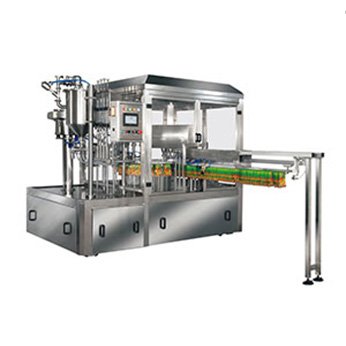Have you ordered takeout recently? You may have noticed that packaging machines are deeply integrated into the entire food processing, packaging, preservation, and distribution process in the catering industry. This is particularly true in the fast food, takeout, and pre-prepared food sectors. Efficient and hygienic automated packaging significantly improves food delivery efficiency and food safety. Next, let’s take a look at what machines can be used in different catering scenarios.
🥣 1. Soups and Liquid Foods
Soup-based takeout items (such as snail noodles, hot pot soup base, milk tea, and soy milk) require leak-proof and portable packaging, either in spout bags or plastic bottles.
Spout bags are used to hold soup for takeout, preventing leaks and spills, ensuring safe transportation and consumption. Spout pouches are often made of composite materials such as PET/AL/NY/PE (AL represents an aluminum foil layer). They offer high heat-sealing strength, can withstand external pressures up to 200kg, are drop-resistant, and are resistant to cracking, effectively preventing soup leakage during transportation or consumption. The screw-on cap fits snugly around the spout, making it easy to open and reseal. Tighten the pouch after consumption to isolate air and impurities, preventing secondary contamination. This makes it particularly suitable for split-drinking applications (e.g., large-volume soup bases).
Secondly, it preserves freshness and resists high temperatures, locking in flavor and nutrients. The spout pouch blocks oxygen, moisture, and UV rays, significantly preventing oxidation and protecting the soup from spoilage due to light or air exposure. For example, the aluminum foil barrier on a sour plum soup pouch can extend its refrigerated shelf life by 3-5 days.
Third, portability and ease of use enhance the consumer experience. Compared to glass bottles or plastic jars, the spout pouch is over 50% lighter and foldable, saving space in backpacks and making it ideal for mobile use, such as food delivery and camping. The stand-up pouch’s base allows it to stand securely on a tabletop, eliminating the need for handheld storage and making it easy to display and access. The spout opening allows for direct sips or pouring, allowing for precise control of broth volume (e.g., adding broth as needed during cooking) to avoid waste. Fourth, it reduces packaging and logistics costs. Material usage is 30%-50% less than rigid containers, and empty bags can be flattened for transportation, saving storage and logistics space and reducing overall costs by approximately 20%.
Technical Solution:
Spout Pouch Filling Machine: A high-precision flow sensor controls the filling volume with an error of ≤1%, preventing leakage during transportation. The spout design allows for multiple openings and closings for convenient drinking. The bag body is made of a PET/NY/PE composite material, which is pressure-resistant and drop-resistant (e.g., soy milk and juice bags).
Fully Automatic Liquid Filling Machine: For example, a snail noodle soup filling machine integrates a vacuum nozzle and heat-sealing technology to simultaneously complete filling, sealing, and coding. It can process 30-60 bags per minute and is suitable for liquids of varying viscosities (from clear soups to sauces).
🥖 2. Bread and Dry Foods: Back-Seal/Pillow-Type Automatic Packaging
Applications: Dry foods such as bread, biscuits, and hamburger buns require packaging that is airtight, moisture-proof, and maintains freshness.
Technical Solution:
Back-seal pillow packaging machines, utilize a servo system to precisely control bag length (with an accuracy of ±0.5mm). The back-seal structure enhances sealing and prevents oil oxidation. Operating speeds reach 40-80 bags/minute, making them suitable for regular, block-shaped foods (bread, egg tarts).
Dual-frequency pillow packaging machines: Support nitrogen filling for freshness preservation, extending shelf life. Automatic parameter adjustment allows for quick switching between packaging formats (e.g., switching between foods of varying lengths).
🍱 3. Fast Food Lunch Boxes: Fully Automatic Sealing and Freshness Locking System
Application: Takeout lunch boxes require efficient packaging, freshness preservation, and spill prevention.
Technical Solution:
Vacuum packaging machine: Vacuums are then injected with nitrogen to extend shelf life up to 72 hours.
Automatic Tray Sealing Machine: Modified atmosphere packaging machine for fruits, vegetables and food.
Intelligent Sealing Correction System: Ensures seal position accuracy of ±0.5mm to prevent juice leakage. UV inkjet coding enables batch traceability.
🥬 4. Pre-prepared Meals: Vacuum and Modified Atmosphere Packaging Technology
Application Scenario: Semi-finished dishes (raw or cooked) pre-processed in a central kitchen require long-term freshness and distribution.
Technical Solution:
Pre-made bag vacuum packaging machine: Automates bag opening, filling with solid ingredients, adding broth, vacuuming, and sealing. Customized degassing solutions are used for raw products (such as lotus root in water); the shelf life of cooked products (stews) is extended to 6 months.
Freshness-Locking Technology: Chamber vacuum machines are used to replace air in fresh produce, combined with cold chain transportation to preserve the moisture and flavor of the ingredients.
⚙️ 5. Multifunctional Extended Applications
Takeout Anti-Spill Packaging: Vacuum-sealed soup cups and curry containers prevent spillage during delivery, enhancing hygiene.
Cost and Efficiency Optimization: Pre-packaging semi-finished dishes in bulk reduces store labor costs and reduces food waste by 30%.
💎 Summary
Packaging machine technology, by enhancing three core values: automation, precision, and freshness preservation, is reshaping efficiency and quality standards in the restaurant industry:
Efficiency Improvement: Vacuum packaging of pre-prepared meals with simple reheating in-store, enabling food to be ready in just 3 minutes;
Safety and Compliance: Sealing prevents contamination, and the data traceability system meets ISO 22000 certification;
Quality Improvement: Modified atmosphere technology preserves the original flavor of ingredients, ensuring a freshly prepared taste upon opening the bag;
Cost Optimization: Large-scale pre-packaging reduces labor and food waste, facilitating the rapid expansion of chain restaurants.
Future trends will focus on intelligent integration (such as all-in-one filling, sealing, and labeling machines) and the use of environmentally friendly materials to further address the restaurant industry’s demand for cost reduction and sustainability.





